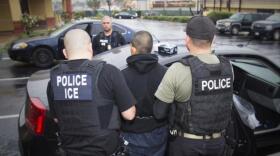Formula One – and thousands of race fans – are descending upon Las Vegas this weekend, but a different kind of vehicle was spotted in town ahead of the race: A low-flying helicopter.
The Aerial Measuring System (AMS) helicopter was flown about 150 feet over the Grand Prix track, which includes part of the Las Vegas Strip, to measure radiation levels. The testing falls under the U.S. Department of Energy’s effort to respond to radiological and nuclear emergencies.
AMS Supervisor Dr. Jacqueline Brandon led the team of seven people who looked for radiation irregularities.
“We’re doing this for national security,” Brandon said. “These major public events it's always good to have a background survey in case anything were to happen, then we’d have a better idea of where a release were to occur and make sure there are no irregularities that need to be checked out.”
Naturally occurring radioactive minerals are in the ground, soil, and water, which produce background radiation. The human body even contains some of these minerals. Brandon explained that every city can have different levels of radioactivity based on its location and other variables like building materials.
Brandon said people shouldn’t be fearful. Instead, they should think of their low-flying team as an extra measure of security ready to respond – if and when they’re needed.
The radiation detection teams deploy all around the country to major gatherings to assure safety. They will be back in Las Vegas for New Year’s Eve and may be spotted in Washington, D.C. during the inauguration in January, and at the Super Bowl in New Orleans in February.
This story was produced by the Mountain West News Bureau, a collaboration between Wyoming Public Media, Nevada Public Radio (KNPR) in Las Vegas, Boise State Public Radio in Idaho, KUNR in Nevada, KUNC in Colorado and KANW in New Mexico, with support from affiliate stations across the region. Funding for the Mountain West News Bureau is provided in part by the Corporation for Public Broadcasting.









